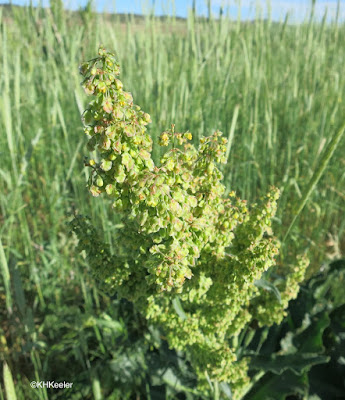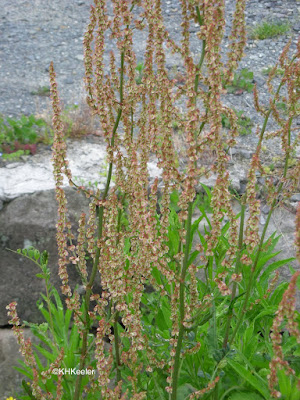They stand out in the grass or beside the fence.
It is curly dock, also called yellow dock and sour dock, Rumex crispus, buckwheat family, Polygonaceae. Curly dock came from Europe and is a worldwide weed. I've seen it in
Oslo, Norway
on Jeju Island, South Korea
in Lisbon, Portugal
Edmonton Alberta
and Loveland Colorado
I could go on...curly dock is found all over the Northern Hemisphere.
And probably all over the cooler parts of the Southern Hemisphere: this sighting was on the southern tip of South America, Ushuaia, Argentina.
There are at least 200 species of Rumex, called sorrels as well as docks. Sixty three species of Rumex are found in North America, some native, some from Eurasia. Curly dock is one of the biggest, with leaves that wave or curl and grow up to a foot long. It is native somewhere in Eurasia but came to North America soon after the Europeans.
No meaning is given for Rumex, it is simply the name the Romans called these plants. Botanists speculate that it is from the Latin rumo, meaning to suck, because the Romans allegedly sucked the leaves to alleviate thirst. The species epithet of curly dock, crispus, means curled, referring to the distinctive waving of the leaves (see that first set of photos).
 |
| Curly dock seed pods |
Curly dock is a perennial with a deep tap root. It may grow four feet high. The flowers are small, greenish or reddish, very inconspicuous. The seed pods, however, are easy to spot, standing above the plant in masses. Dark brown when ripe, there is one seed per small papery pod. My pictures looks like the plants with the red-brown seeds are dead, but they are not, they are dormant and will be back next year.
Curly dock will grow in good soils, but tolerates poor ones, making it a hardy weed. In particular it grows well in wet and acid soils, so much so that a dense stand of curly dock indicates wet, acid conditions.
 |
| A low spot with many curly dock plants |
As a perennial, you can cut off the top to remove it, but if you don't get virtually all of the roots, it will regrow. They clump rather than form large clones, however.
One other reason curly dock is a tough weed is that the seeds can last a long time in the soil. We have few studies of seed longevity, because long-lived seeds outlast the careers of scientists. Curly dock was one of the seeds in Professor Beal's famous study of seed survival at Michigan State University. Begun in 1890 and still running, bottles with seeds were set in the ground and after various intervals, dug up and planted to see if the seeds were still alive. (Beal's experiment) The curly dock seeds came up in all the planting experiments up to 80 years, but not at or after 90 years. Eighty years is a long time that the seeds can lie in the soil alive and waiting for favorable conditions: the property might well have five different owners in that period, before one is surprised to see dock in her garden.
Currently, curly dock is reported from every state, province and territory on the USDA's plant distribution map except Arctic Canada (map). In Arkansas is it a noxious weed, which means the state is actively trying to eradicate it, and Iowa mentions it as a minor noxious weed, that is, they don't want it but are not spending money getting rid of it. But all across the rest of the continent, it is just a European plant found in waste areas and disturbed sites. It isn't spiny or toxic or a vine that makes harvesting crops difficult.
That's faint praise...I will talk about its folklore and uses (it is tasty!) next post.
For now: notice curly dock, if you are not in the tropics, it almost certainly grows near you.
Comments and corrections welcome.
References
Jones, P. 1994. Just weeds. History, myths and uses. Chapters Publishers and Booksellers, Shelburne, Vermont.
Minnesota wildflowers.info Curly dock link
Return to Nature Curly dock, Rumex crispus. Returntonature.us link
W.J.Beal Botanical Garden, East Lansing, MI. Research and teaching. link Summary of Beal's experiment.
Kathy Keeler, A Wandering Botanist
More at awanderingbotanist.com









I respect this article for the all around scrutinized content and superb wording. I got so included in this material that I couldn't quit perusing. I am inspired with your work and expertise. Much thanks to you to such an extent. true north vape
ReplyDelete